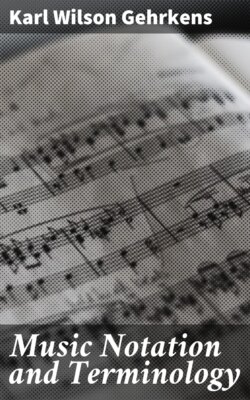Читать книгу Music Notation and Terminology - Karl Wilson Gehrkens - Страница 12
На сайте Литреса книга снята с продажи.
Abbreviations, Signs, Etc.
ОглавлениеTable of Contents
36. A double bar (or single heavy bar) with either two or four dots indicates that a section is to be repeated. If the repeat marks occur at only one point the entire preceding part is to be repeated, but if the marks occur twice (the first time at the right of the bar but the second time at the left), only the section thus enclosed by the marks is to be repeated.
37. Sometimes a different cadence (or ending) is to be used for the repetition, and this is indicated as in Fig. 24.
38. The Italian word bis is occasionally used to indicate that a certain passage or section is to be repeated. This use is becoming obsolete.
39. The words da capo (D.C.) mean literally "from the head," i.e., repeat from the beginning. The words dal segno (D.S.) indicate a repetition from the sign ( or ) instead of from the beginning.
In the case of both D.C. and D.S. the word fine (meaning literally the end) is ordinarily used to designate the point at which the repeated section is to terminate. The fermata () was formerly in common use for this same purpose, but is seldom so employed at present.
D.C. (sin[9]) al fine means—repeat from the beginning to the word "fine."
D.C. al means—repeat to the fermata (or hold).
D.C. senza repetizione, or D.C. ma senza repetizione, both mean—repeat from the beginning, but without observing other repeat marks during the repetition.
D.C. e poi la coda means—repeat the first section only to the mark , then skip to the coda. (See p. 74, Sec. 157, for discussion of coda).
40. In certain cases where the repetition of characteristic figures can be indicated without causing confusion, it is the practice of composers (especially in orchestral music) to make use of certain signs of repetition. Some of the commonest of these abbreviations are shown in the following examples.
[Listen]
In Fig. 28 the repetition of an entire measure is called for.
[Listen]
41. The word simile (sometimes segue) indicates that a certain effect previously begun is to be continued, as e.g., staccato playing, pedalling, style of bowing in violin music, etc. The word segue is also occasionally used to show that an accompaniment figure (especially in orchestral music) is to be continued.
42. When some part is to rest for two or more measures several methods of notation are possible. A rest of two measures is usually indicated thus . Three measures thus . Four measures thus . Rests of more than four measures are usually indicated in one of the following ways: . Sometimes the number of measures is written directly on the staff, thus; .
43. The letters G.P. (general pause, or grosse pause), the words lunga pausa, or simply the word lunga, are sometimes written over a rest to show that there is to be a prolonged pause or rest in all parts. Such expressions are found only in ensemble music, i.e., music in which several performers are engaged at the same time.
44. The fermata or hold over a note or chord indicates that the tone is to be prolonged, the duration of the prolongation depending upon the character of the music and the taste of the performer or conductor. It has already been noted that the hold over a bar was formerly used to designate the end of the composition, as the word fine is employed at present, but this usage has practically disappeared and the hold over the bar now usually indicates a short rest between two sections of a composition.
45. The sign 8va … … (an abbreviation of all'ottava, literally at the octave) above the staff, indicates that all tones are to be sounded an octave higher than the notes would indicate. When found below the staff the same sign serves to indicate that the tones are to be sounded an octave lower. The term 8va bassa has also this latter signification.
46. Sometimes the word loco (in place) is used to show that the part is no longer to be sounded an octave higher (or lower), but this is more often indicated by the termination of the dotted (or wavy) line.
47. The sign Col 8 (coll'ottava—with the octave) shows that the tones an octave higher or lower are to be sounded with the tones indicated by the printed notes.
48. For the sake of definiteness in referring to pitches, a particular name is applied to each octave, and all pitches in the octave are referred to by means of a uniform nomenclature. The following figure will make this system clear:
Thus e.g., "great G" (written simply G), is the G represented by the first line of the bass staff. Small A (written a), is represented by the fifth line of the bass staff. Two-lined G, (written ), is represented by the space above the fifth line, treble staff. Three-lined C, (written ), is represented by the second added line above the treble staff, etc. The one-lined octave may be described as the octave from middle C to the B represented by the third line of the treble staff, and any tone within that octave is referred to as "one-lined." Thus—one-lined D, one-lined G, etc.
In scientific works on acoustics, etc., the pitches in the sub octave (or sub-contra octave as it is often called) are referred to as C2, D2, E2, etc.; those in the contra octave as C1, D1, etc.; in the great octave, as c1, d1, etc.; in the small octave as c2, d2, etc.
